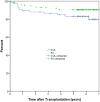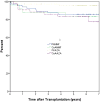BK-virus and the impact of pre-emptive immunosuppression reduction: 5-year results
- PMID: 20055811
- PMCID: PMC3188431
- DOI: 10.1111/j.1600-6143.2009.02952.x
BK-virus and the impact of pre-emptive immunosuppression reduction: 5-year results
Abstract
A 1-year, single-center, randomized trial demonstrated that the calcineurin inhibitor or adjuvant immunosuppression, independently, does not affect BK-viruria or viremia and that monitoring and pre-emptive withdrawal of immunosuppression was associated with resolution of BK-viremia and absence of clinical BK-nephropathy without acute rejection or graft loss. A retrospective 5-year review of this trial was conducted. In cases of BK viremia, the antimetabolite was withdrawn and for sustained viremia, the calcineurin inhibitor was minimized. Five-year follow-up was available on 97% of patients. Overall 5-year patient survival was 91% and graft survival was 84%. There were no differences in patient-survival by immunosuppressive regimen or presence of BK-viremia. Immunosuppression and viremia did not influence graft survival. Acute rejection occurred in 12% by 5-years after transplant, was less common with tacrolimus versus cyclosporine (9% vs. 18%; p = 0.082), and was lowest with the tacrolimus-azathioprine regimen (5%, p = 0.127). Tacrolimus was associated with better renal function at 5-years (eGFR 63 FK vs. 52 CsA mL/min, p = 0.001). Minimization of immunosuppression upon detection of BK-viremia was associated with excellent graft survival at 5-years, low rejection rates and excellent renal function. It is a safe, short and long-term strategy that resulted in freedom from clinically evident BK-virus nephropathy.
Figures



Similar articles
-
Incidence of BK with tacrolimus versus cyclosporine and impact of preemptive immunosuppression reduction.Am J Transplant. 2005 Mar;5(3):582-94. doi: 10.1111/j.1600-6143.2005.00742.x. Am J Transplant. 2005. PMID: 15707414 Clinical Trial.
-
Association of BK viremia with human leukocyte antigen mismatches and acute rejection, but not with type of calcineurin inhibitor.Transpl Infect Dis. 2014 Feb;16(1):44-54. doi: 10.1111/tid.12153. Epub 2013 Oct 18. Transpl Infect Dis. 2014. PMID: 24134704
-
BK viremia surveillance after kidney transplant: single-center experience during a change from cyclosporine-to lower-dose tacrolimus-based primary immunosuppression regimen.Transpl Infect Dis. 2011 Apr;13(2):109-16. doi: 10.1111/j.1399-3062.2010.00566.x. Epub 2010 Sep 7. Transpl Infect Dis. 2011. PMID: 21457419
-
BK virus replication following kidney transplant: does the choice of immunosuppressive regimen influence outcomes?Ann Transplant. 2012 Jan-Mar;17(1):86-99. doi: 10.12659/aot.882640. Ann Transplant. 2012. PMID: 22466913 Review.
-
The influence of immunosuppressive agents on BK virus risk following kidney transplantation, and implications for choice of regimen.Transplant Rev (Orlando). 2012 Jul;26(3):201-11. doi: 10.1016/j.trre.2011.05.002. Epub 2011 Sep 21. Transplant Rev (Orlando). 2012. PMID: 21940156 Review.
Cited by
-
Reining in polyoma virus associated nephropathy: design and characterization of a template mimicking BK viral coat protein cellular binding.Biochemistry. 2012 Oct 16;51(41):8092-9. doi: 10.1021/bi300639d. Epub 2012 Oct 2. Biochemistry. 2012. PMID: 23002929 Free PMC article.
-
BK Virus Nephropathy in Kidney Transplantation: A State-of-the-Art Review.Viruses. 2022 Jul 25;14(8):1616. doi: 10.3390/v14081616. Viruses. 2022. PMID: 35893681 Free PMC article. Review.
-
Kidney Fibrosis: Origins and Interventions.Transplantation. 2017 Apr;101(4):713-726. doi: 10.1097/TP.0000000000001608. Transplantation. 2017. PMID: 27941433 Free PMC article. Review.
-
Graft Function and Intermediate-Term Outcomes of Kidney Transplants Improved in the Last Decade: Analysis of the United States Kidney Transplant Database.Transplant Direct. 2017 May 25;3(6):e166. doi: 10.1097/TXD.0000000000000654. eCollection 2017 Jun. Transplant Direct. 2017. PMID: 28620650 Free PMC article.
-
Putative episodes of T-cell-mediated rejection in patients with sustained BK viruria but no viremia.Transplantation. 2012 Jul 15;94(1):43-9. doi: 10.1097/TP.0b013e318253e7a4. Transplantation. 2012. PMID: 22691957 Free PMC article.
References
-
- Ramos E, Drachenberg CB, Portocarrero M, Wali R, Klassen DK, Fink JC, et al. BK virus nephropathy diagnosis and treatment: experience at the University of Maryland Renal Transplant Program. Clin Transpl. 2002:143–53. - PubMed
-
- Ramos E, Drachenberg CB, Papadimitriou JC, Hamze O, Fink JC, Klassen DK, et al. Clinical course of polyoma virus nephropathy in 67 renal transplant patients. J Am Soc Nephrol. 2002;13:2145–51. - PubMed
-
- Buehrig CK, Lager DJ, Stegall MD, Kreps MA, Kremers WK, Gloor JM, et al. Influence of surveillance renal allograft biopsy on diagnosis and prognosis of polyomavirus-associated nephropathy. Kidney Int. 2003;64:665–73. - PubMed
-
- Mengel M, Marwedel M, Radermacher J, Eden G, Schwarz A, Haller H, et al. Incidence of polyomavirus-nephropathy in renal allografts: influence of modern immunosuppressive drugs. Nephrol Dial Transplant. 2003;18:1190–96. - PubMed
-
- Gardner SD, Field AM, Coleman DV, Hulme B. New human papovavirus (B.K.) isolated from urine after renal transplantation. Lancet. 1971;1:1253–7. - PubMed
Publication types
MeSH terms
Substances
Grants and funding
LinkOut - more resources
Full Text Sources
Research Materials
Miscellaneous

